Alamosa's Sanctioned Camp Takes Care of Its People
Photos and Story by Giles Clasen
IT TOOK CHRISTI BUCHANAN and Ricky Plunkett two years to get to Colorado from Texas.
The two fled their home in East Texas to get away from a life of addiction, poverty, and trauma. Buchanan and Plunkett hoped to make a fresh start in Colorado Springs.
Neither had a car, so they rolled through Texas on bicycles, sleeping in parks, shelters, and on the side of the road. They worked when they could find jobs, and hit up food pantries when they couldn’t.
Their journey was slowed multiple times due to weather, breakdowns, and an arrest. Plunkett spent three months in jail in Trinidad, Colorado. He was ticketed for violating the town’s camping ban. When he couldn’t pay, he was arrested.
Buchanan stayed in a Trinidad shelter while Plunkett served his time, and she felt something deep inside telling her to change directions and head to the San Luis alley.
“God just was like, ‘You need to go to Alamosa,’” Buchanan said. “And I’m like, ‘I’m not changing my plans at the last minute.’ I just kind of ignored it. But you can’t ignore God. Once I accepted that we needed to go to Alamosa, Ricky was freed.”
Plunkett wasn’t sure about the idea, but he decided home was wherever Buchanan was, and that included Alamosa.
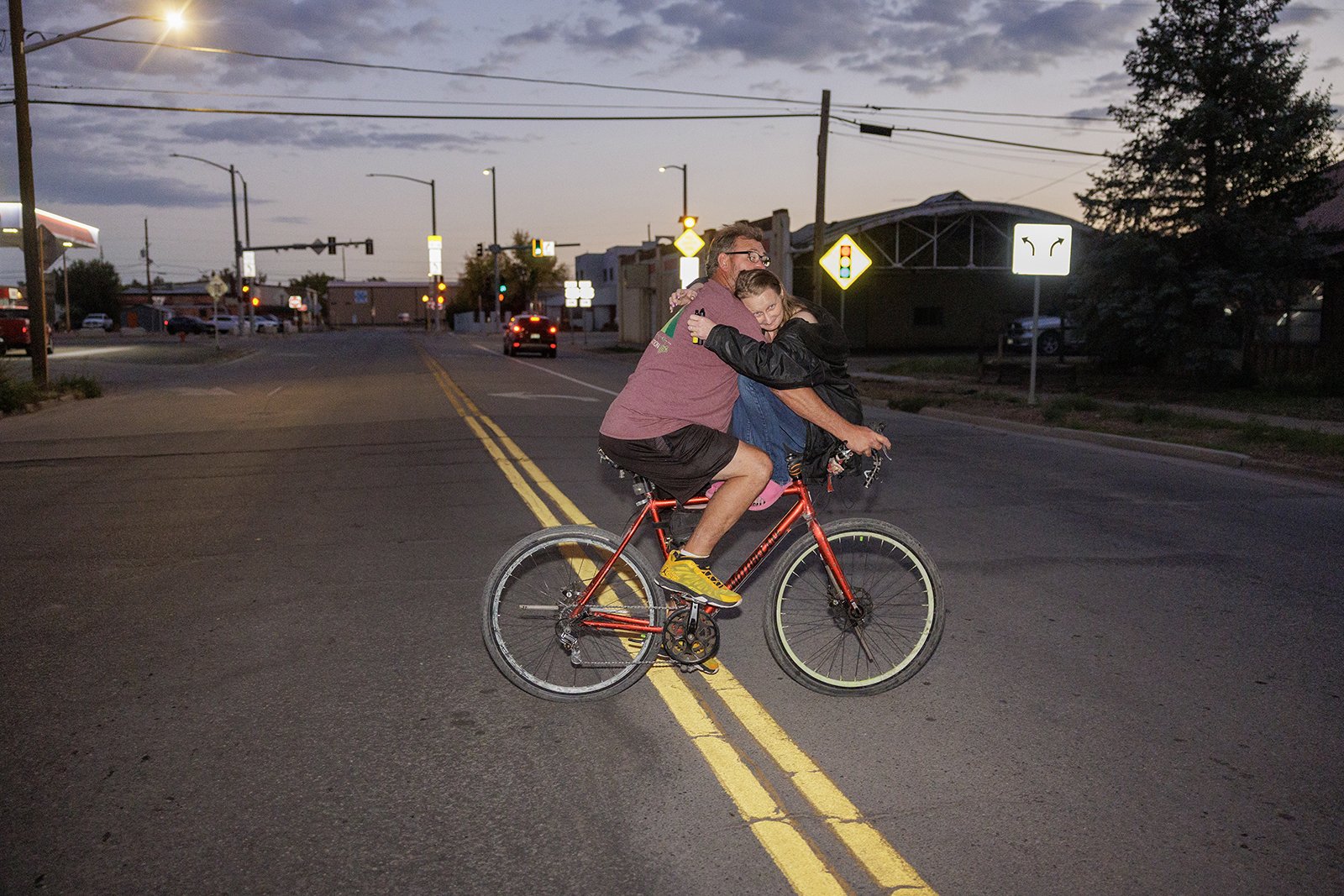
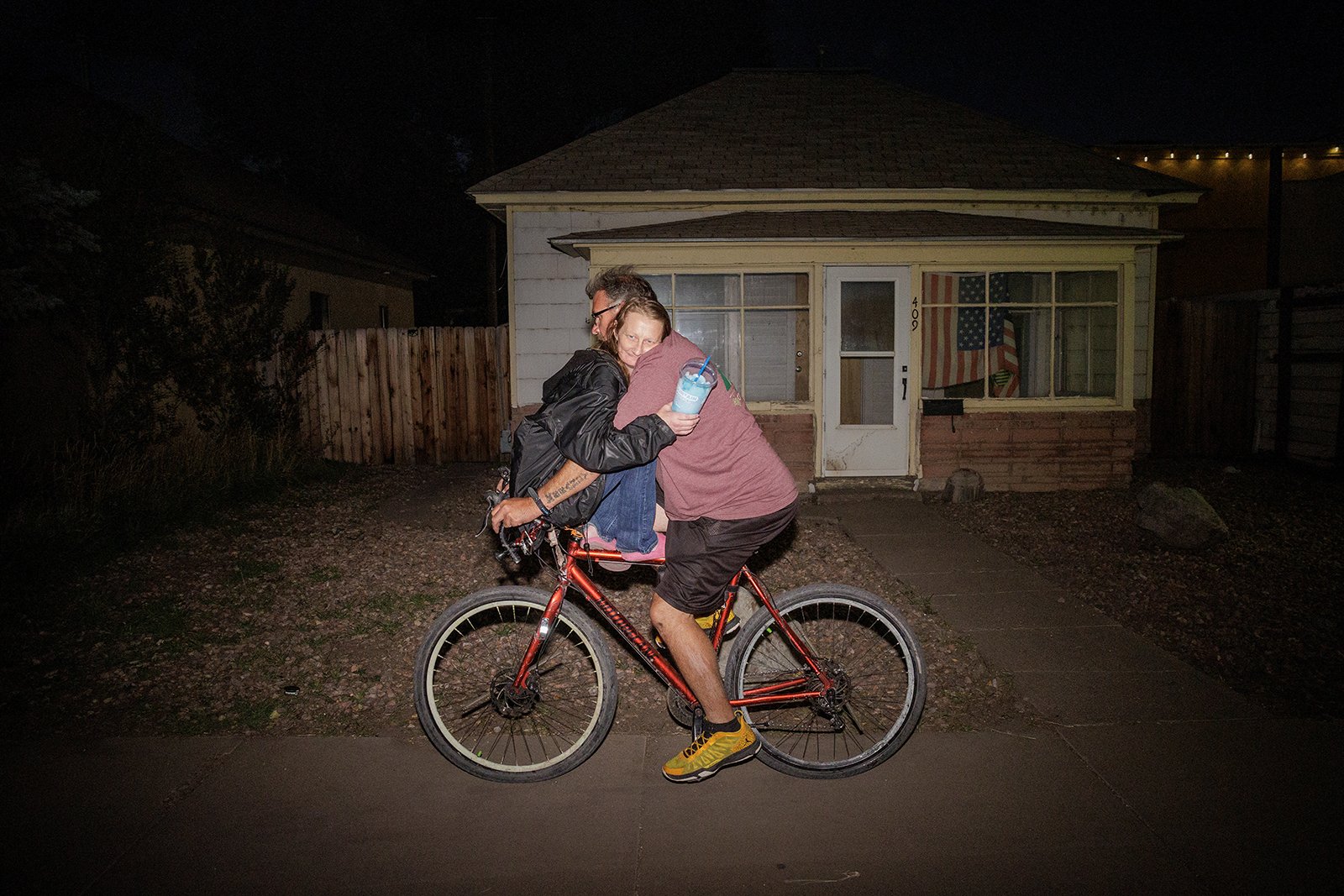
Christi Buchanan and Ricky Plunket rode their bikes from Texas to Alamosa before finding help at the St. Benedict encampment.
The first winter in Alamosa nearly cost the two their lives.
The San Luis winters are notoriously cold, and Plunkett and Buchanan weren’t prepared.
“When we moved out, it was in the middle of winter. It was like negative 26 degrees. That was our first real winter, and it was an awakening for what we were in for,” Plunkett said.
For the first 18 months, Plunkett and Buchanan lived at an unsanctioned campsite in the Devil’s Triangle, a strip of private property along the Rio Grande River hidden by railroad tracks.
Then, the City of Alamosa made a decision: it planned to sweep the homeless encampments along the river and relocate the community to a new sanctioned campsite St. Benedict.
“We didn’t want to go, but we made the best of it,” Buchanan said. “We went to the very back corner, and we put up tarps and stuff and made like a shelter. We had a woodburning stove in it and all that good stuff there. We still froze our asses off. But we survived, and it was home, kind of.”
ST. BENEDICT CAMP
The St. Benedict Camp opened in Alamosa with federal COVID funds and private foundation support to provide a sanctioned campsite for the unhoused community. The site, which is on the outskirts of town, has running water, bathrooms, trash services, and limited electricity. Police patrolled the camp throughout the day, and security cameras were put up.
La Puente, a nonprofit addressing poverty and homelessness in the San Luis Valley, provided individuals with tents and winter survival gear. The outreach team delivered other supplies as needed.
“It was a pretty negative experience when individuals first started moving in, just because it is hard for folks to have police tell them they have to move,” said Christina Bolt, La Puente’s street outreach director. “But I think that overall, most of our folks who are living out there have recognized some of the benefits that have come with having that city sanctioned area to stay.”
One of the camp’s benefits is that it is easier to deliver services at a central location, and less time is spent locating and accessing individual campsites.
“We are able to go out there and just sit for a couple of hours with a laptop and get all sorts of stuff done for people. We were able to get people enrolled in new services and meet a lot of needs really quickly,” Bolt said.
The camp doesn’t have a manicured lawn. It is a wild piece of land with sage and tumbleweeds creating a thick layer of brush. A dirt road winds through the camp, and during the early months, tourists drove through the camp gawking.
With input from the camps resident changes were made, and St. Benedict took shape as a community with security and stability for those camped at the site.
Popeye has participated in the St. Benedict encampment for over a year. "I'm not homeless, this is our home," he said.
“I’m not homeless. This is our home,” said Popeye, a St. Benedict resident. “I’ve been here for a year. A lot of people here have special needs. People here came from violence and tough backgrounds and are trying to get by. This place isn’t perfect, but it offers some hope.”
Popeye became homeless following a divorce. He is on disability due to a back injury he sustained while working in construction. He said he lives with addiction to opiates after being prescribed the painkillers following his injury.
Popeye’s addiction ultimately led to a drug conviction.
“I tried to find a job, but they won’t hire felons out here. There aren’t many second chances when everyone knows you and has labeled you,” Popeye said. “This camp, though, this camp is a second chance for a lot of us.”
The camp has helped Popeye create a home for himself, but he feels it isn’t enough. He is frustrated that the City of Alamosa has ticketed and towed residents’ vehicles parked in a nearby parking lot.
He also feels the rules are enforced too harshly and inconsistently by the police. Popeye said he feels like the rules are there as a weapon against the residents more than to keep the peace.
“There are so many stories here, but they don’t listen. How do they expect us to find a job or work when they take our cars?” Popeye said. “The city and police see us as a problem. They say they’re helping, but they’re not helping. If they’re going to help, then help by listening to us.”
Popeye said there are still barriers to overcoming homelessness that the city could help remove.
Angelo camps in the St. Benedict encampment in Alamosa but feels more needs to be done to break down barriers that perpetuate homessness.
THE COMPROMISE
The St. Benedict camp was created because federal courts once prevented local government camping bans when there was not alternative shelter.
Homelessness had become a bigger issue for Alamosa, and there was public demand in city council meetings to sweep unsanctioned encampments. To sweep the unsanctioned camps, Alamosa had to offer an alternative shelter, and St. Benedict became the solution.
But Alamosa Mayor Ty Coleman contends St. Benedict wasn’t simply created to meet the legal requirements to sweeping unsanctioned campsites.
“The thing about people who are homeless: we have to always remember that these are human beings,” Coleman said. “They’re deserving of community support and a second chance. And St. Benedict is just one of the ways to support those who are the most vulnerable among us.”
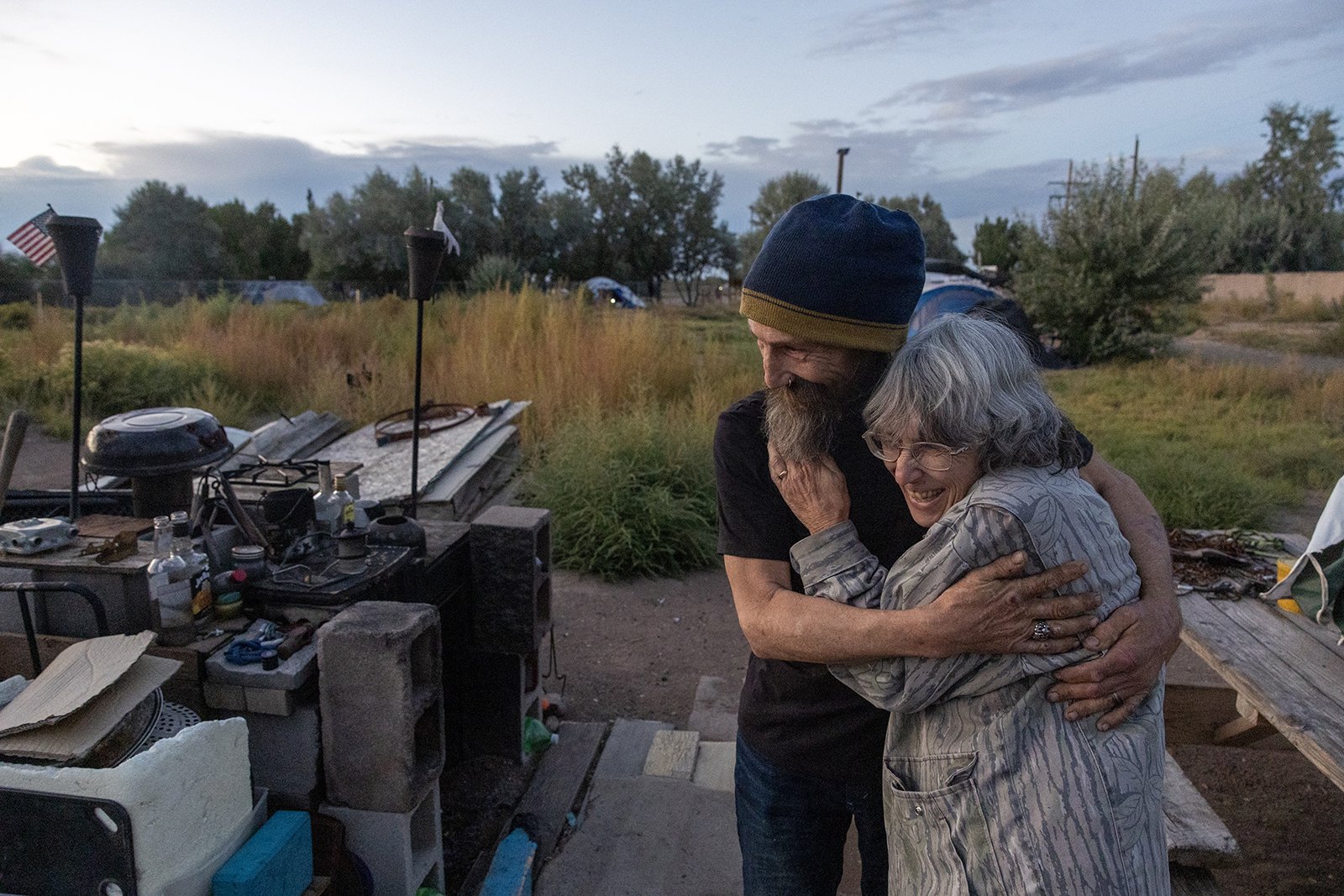
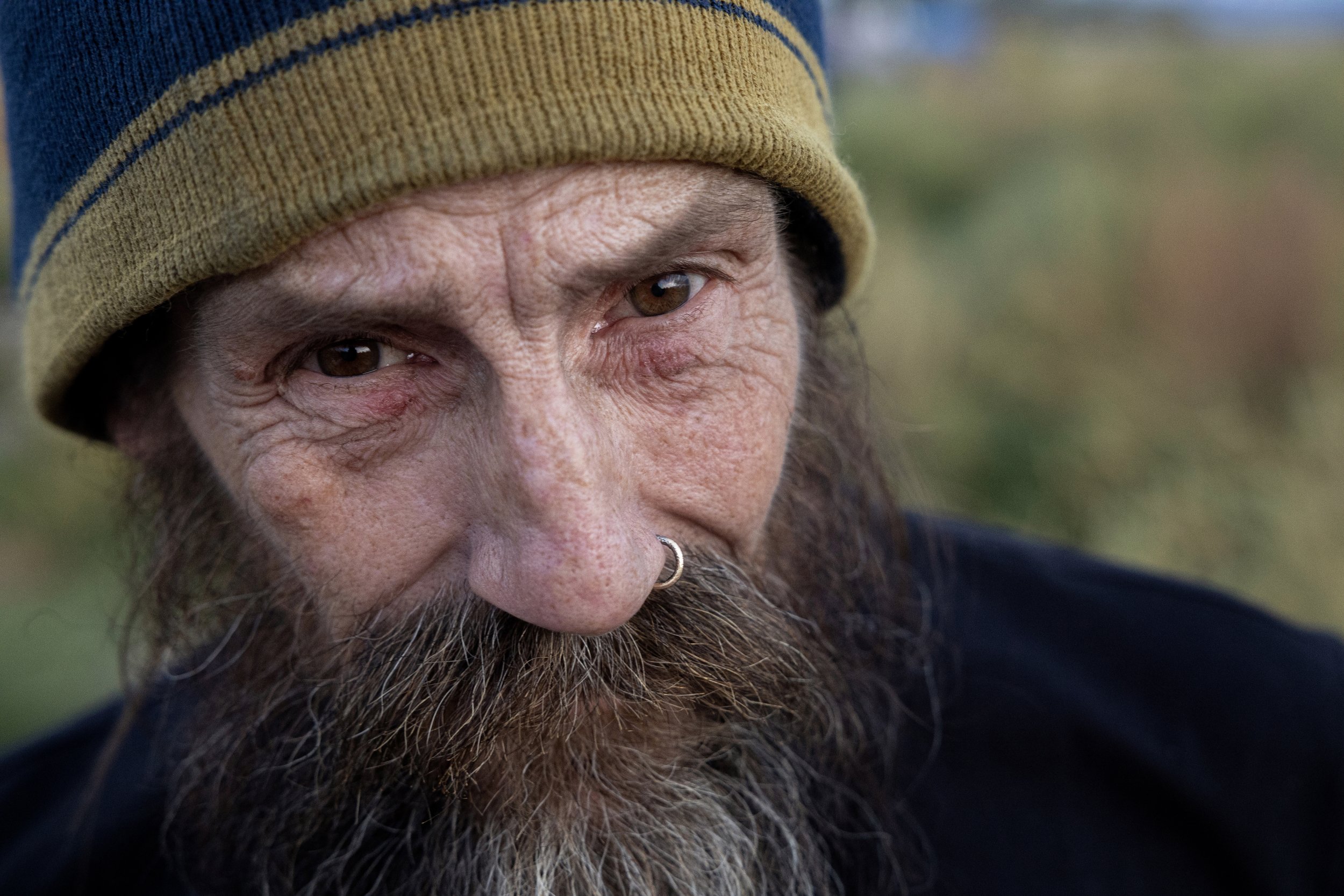
Mike was one of the first residents at St. Benedict camp. His step mom Mary Van Pelt reconnected with him by accident when taking supplies to the camp.
The calculus for keeping St. Benedict open changed this year when the Supreme Court ruled in June on the Grant Pass v. Johnson case. The ruling stated that camping bans were not a violation of the rights of homeless individuals and that homeless encampment sweeps could be completed by local governments, even when alternative shelters aren’t available. Grant Pass meant the City of Alamosa could close St. Benedict, which the City seriously considered doing this past August.
Ultimately, the City chose to keep St. Benedict because it had become a successful way to deliver services and had proved successful in preventing unsanctioned sites from popping up in residential or business areas.
Follow-up discussions lead to new camp rules created in October by the City Council. The most significant change requires individuals to show progress toward overcoming homelessness or face eviction. Individuals can now only live in the camp for six months. After that, they are evaluated on their progress and may be given a six-month extension.
There is no camp manager, and the city police will enforce the rules and evaluations. The police can now ban individuals from the camp for violating the rules. It takes a letter from the Alamosa Police Chief to be reinstated to the camp.
The Alamosa Citizen reported in August that Alamosa Police Chief George Dingfelder advocated for closing the St. Benedict Camp.
Mayor Coleman said he believes the new, more restrictive rules seek to ensure the safety of the Alamosa community and the unhoused individuals residing at the camp.
“I want [individuals experiencing homelessness] to have a place to stay until they get themselves together,” Coleman said. “They are safe and secure at St. Benedict, and we don’t have bad actors over there destroying, being destructive, and causing harm. So, I believe it can be that in the future. But it’s going to take a lot of effort of several different parties to bring about that change we want to see.”
But Coleman said he struggles supporting some of the problems he associates with homelessness, like drug use. Coleman voted in November with the rest of the city council to reject a year-round low-barrier shelter to be run by La Puente.
Coleman said he believes providing low-barrier services allows people to continue with what he sees as behavioral issues that make the community unsafe. Coleman said Alamosa isn’t like other larger cities that can afford to follow a housing first model.
“[The vote] was also based upon the huge public outcry that we’ve heard, and the public wants people to be accountable for their actions,” Coleman said.
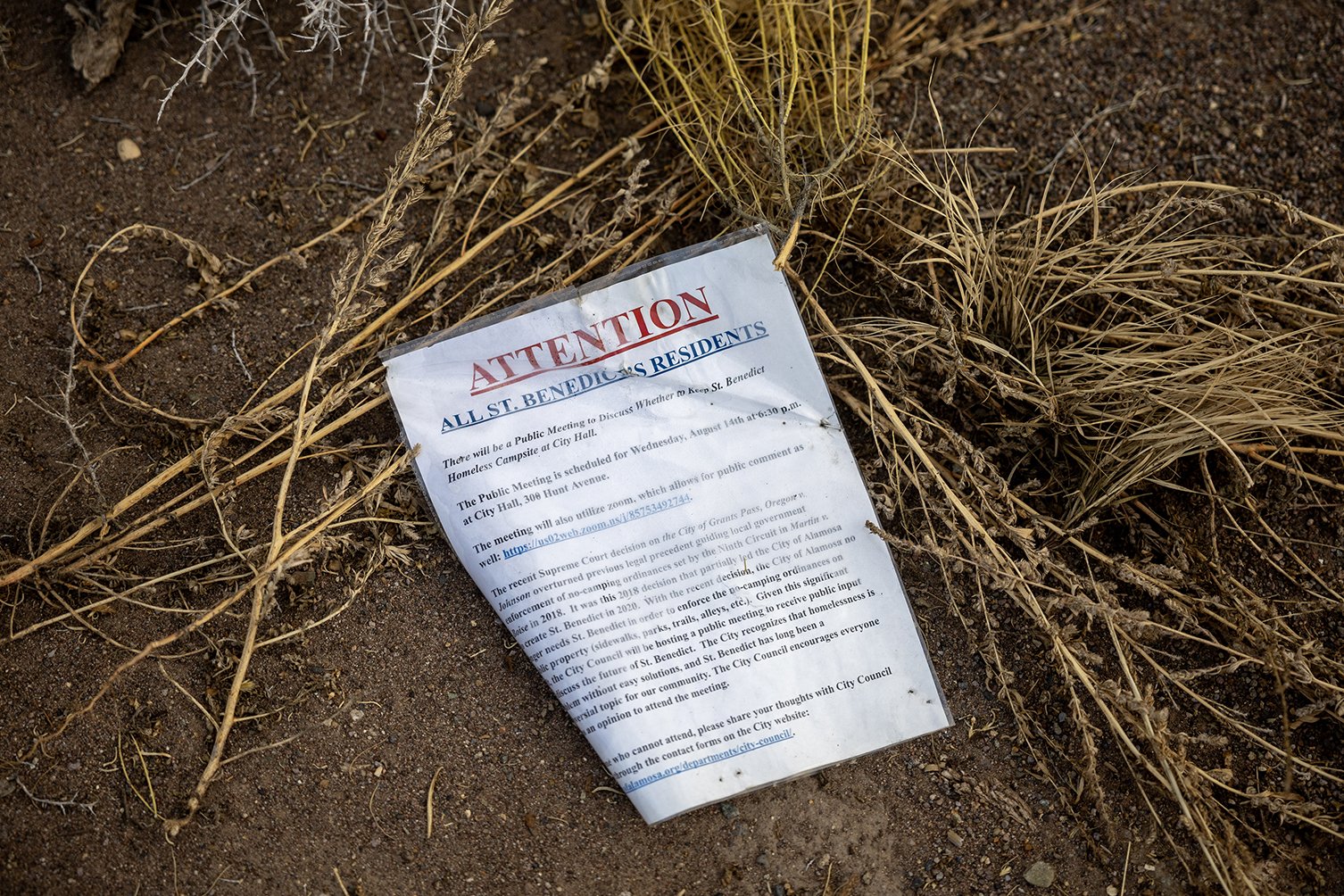
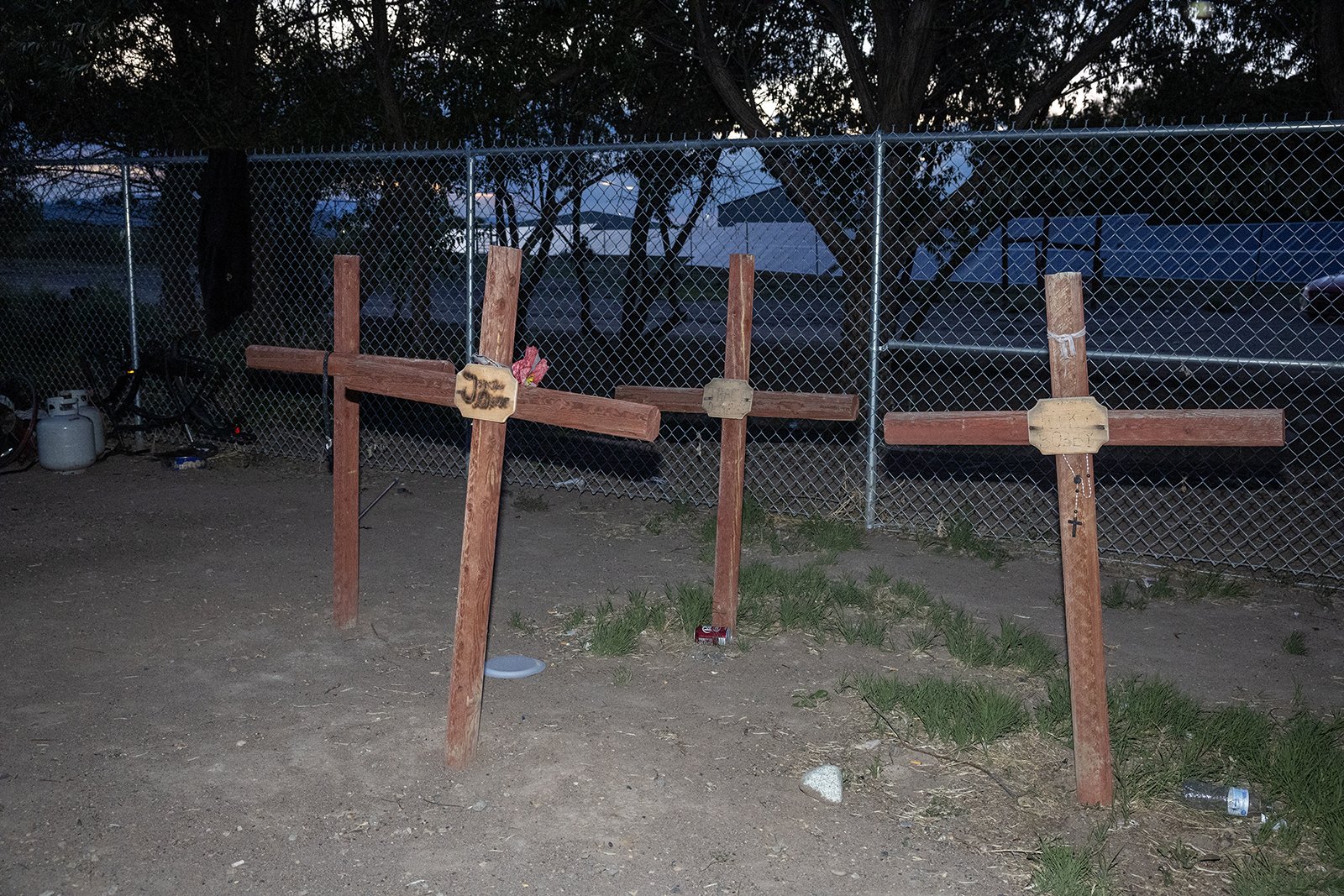
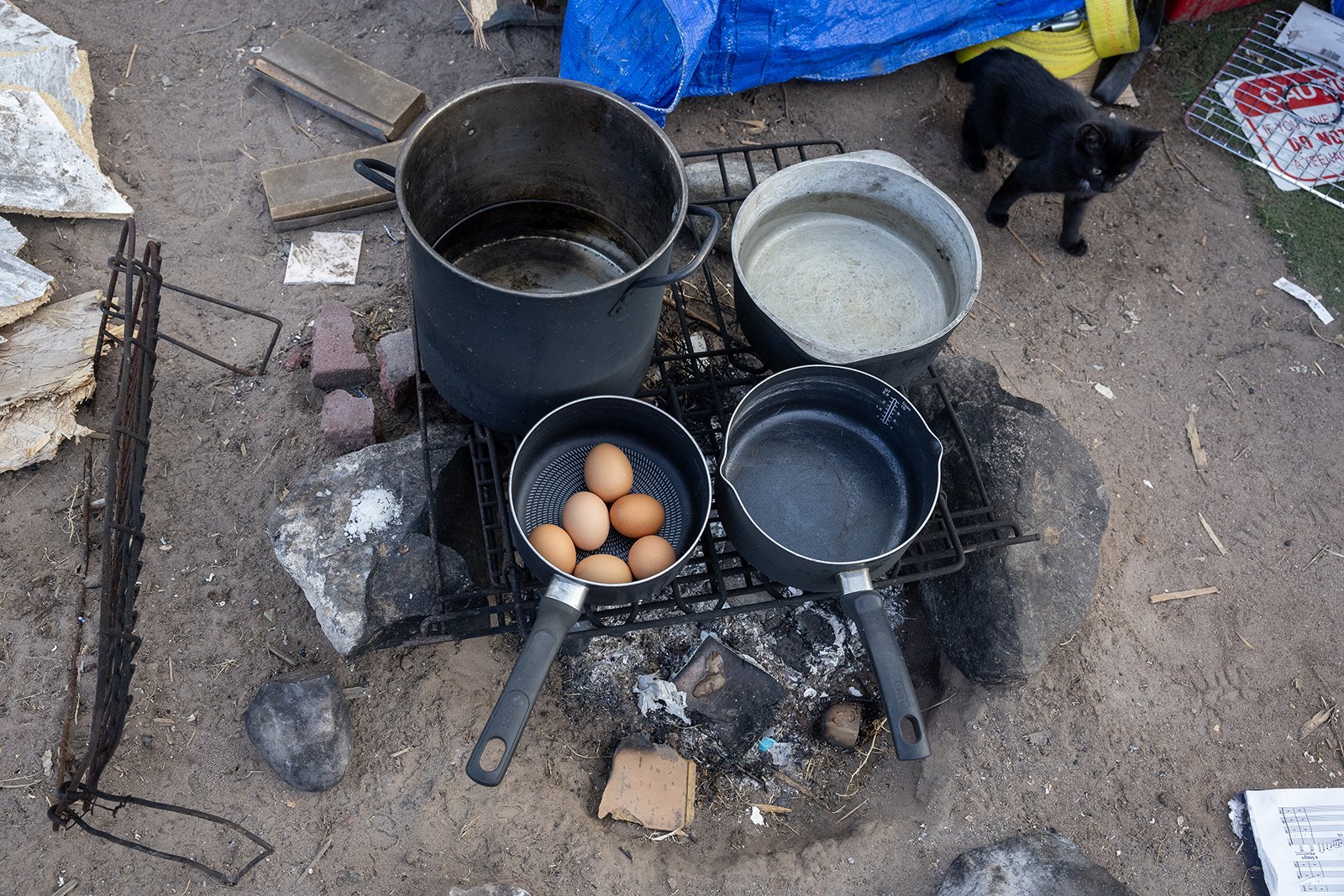
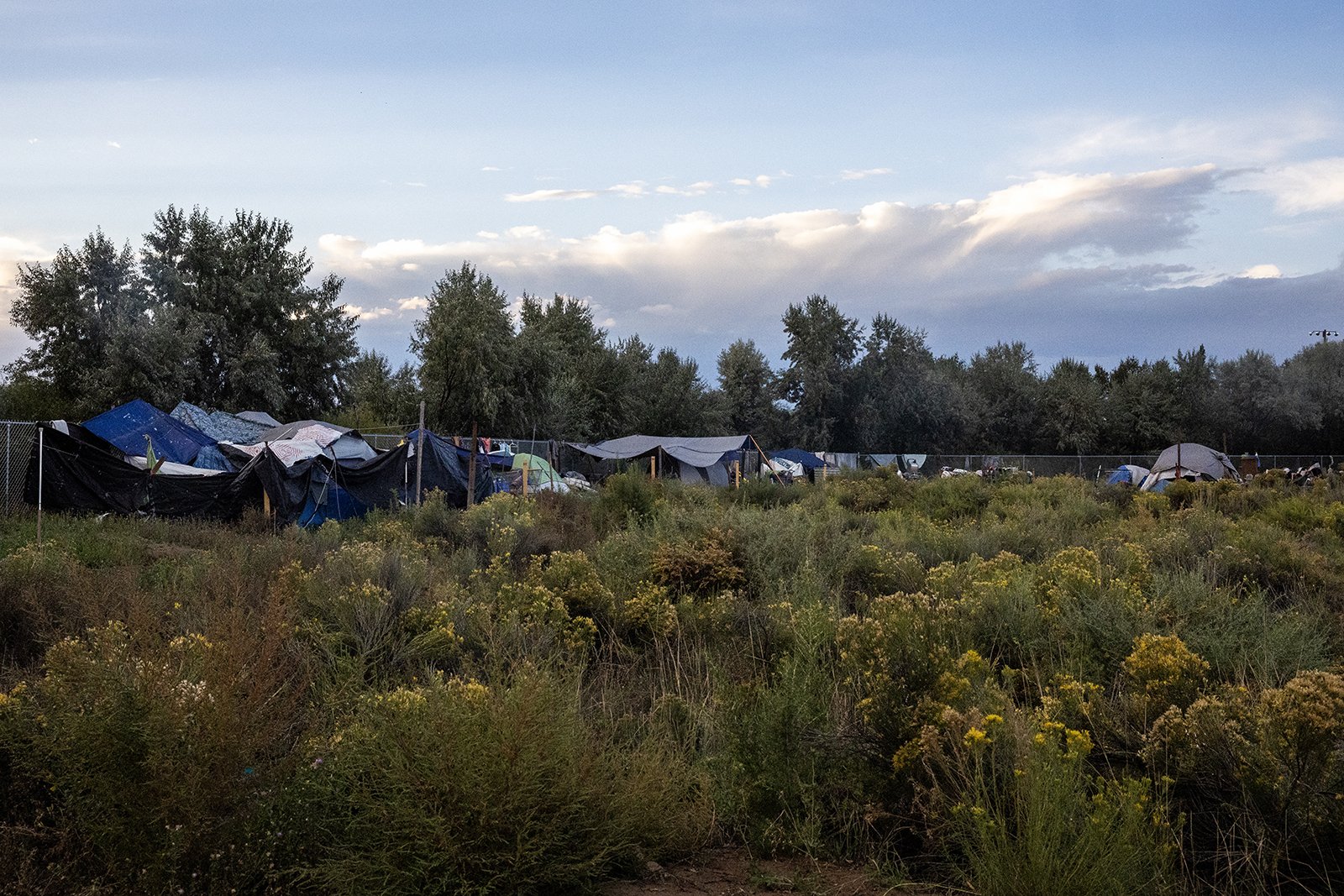
A flyer remains on the ground of the St. Benedict camp, announcing a city meeting to discuss the possible closure of the camp. Ultimately the city chose to keep the camp open but added new more restrictive rules. The camp is a wild piece of land with sage and tumbleweeds creating a thick layer of brush. A dirt road winds through the camp, and during the early months, tourists drove through the camp gawking.
Alamosa City Councilor Jan Vigil believes the St. Benedict camp is a way to strike a balance between the needs of those experiencing homelessness and the wider community.
“I think our community has really stepped up to address homelessness and is trying to address the needs of folks [experiencing homelessness]. We have to balance
their needs and the needs of people in town, businesses, homeowners, and property owners,” Vigil said. “Trying to find that balance has been difficult because homeless folks are our citizens, and they have rights, as well. We need to be there for them too.”
Vigil said those experiencing homelessness in Alamosa are primarily from the San Luis Valley. Only unhoused individuals, like Plunkett and Buchanan, are traveling to Alamosa to seek services. Coleman sees the St. Benedict camp as a way for the Alamosa community to take care of its people.
“What I really like about the Valley is we really protect our own and support our own. There has been some opposition, but really I have seen this community step up and help these folks, and I know we can continue to try and change lives,” Vigil said.
Grizzly has found community and support through participation in the St. Benedict encampment.
Most people understand that if the camp is closed or the city provides less support to those experiencing homelessness, then the unsanctioned camping will pop up near the river and in other public places Vigil said.
Vigil wants to see the City of Alamosa do more to help people recover from homelessness.
“Providing people a place to stay for one year is good. But I worry that it’s not good enough because the Valley doesn’t have a lot of programs for people to move to from the camp,” Vigil said. “The camp’s not enough because it doesn’t really give people the security they need to find a job, get a home, and move on with their lives.”
A COMMUNITY, BOTH GOOD AND BAD
For Christina Bolt with LaPuenta, the camp’s most important service is creating a community for individuals going through a shared experience.
“I don’t think that growth ever happens in isolation. In my life, most of my growth has happened when I’ve had a good community around me,” Bolt said. “I think that when people have other folks to rely on and to go to, it sparks a desire to grow and change.”
Bolt said she has seen people become more motivated to enroll in services, work with a case manager, or try to find a job. The communal nature of the camp has also led to fewer deaths among the unhoused.
“We have seen very few overdose deaths at the camp. Our folks are in community and able to help with Narcan quickly and effectively,” Bolt said. “We have not had any deaths because of exposure out there, either, because if you are not prepared for the winter, people out there will give you tips on how to survive the cold.”
But the community in the camp doesn’t work for everyone. Bolt said it can be hard to live in close proximity under stressful circumstances. The La Puente outreach team continues to serve a small number of individuals who are illegally camped around Alamosa.
Lilelk Dyapp Jones said he has refused to move to the camp because he doesn’t feel safe living near other people.
Being around other people can be toxic for me, “Jones said.
According to Jones, he has had bad experiences with the police and other people living on the street, so he tries to stay hidden and away as much as possible. Jones set up his own camp and is proud of his self-sufficiency.
“The police came and asked me to move but I didn’t want to. I have everything I need here and I don’t bother anyone. I wish [the police] would leave me alone,” Jones said.
Lilelk Dyapp Jones said he has refused to move to the camp because he doesn’t feel safe living near other people. Instead, Jones lives in a hidden camp near Alamosa.
Bolt said more than 25% of St. Benedict residents have moved into homes or apartments. La Puente’s most recent count of unhoused individuals in the Valley recorded the fewest number of unhoused individuals on record, according to Bolt.
There are more factors contributing to the success than just the St. Benedict camp, but she believes the camp played an important role.
MAKING IT TO THE SPRINGS
St. Benedict played a significant role in helping Buchanan and Plunkett get off the street. They both found jobs while living at the camp. Buchanan also connected with behavioral health services at the San Luis Valley Behavioral Health Group and began receiving therapy for trauma from her childhood and first marriage.
“I was depressed and didn’t realize it. I was living with ADHD and PTSD and trying to make it on my own without realizing I was sick,” Buchanan said. “I was constantly having anxiety attacks, and I didn’t even know it. I thought it was normal. It was no wonder my life was a mess.”
Buchanan and Plunkett left the camp to live in an RV.
They had some negative interactions in the camp with the police because of their wood-fired stove, and they felt leaving the camp was their only option. But the two continued to participate in case management, behavioral health, and other services they signed up for while living at St. Benedict. In time, they received a housing voucher and an apartment.
Buchanan’s time at the camp even created the opportunity for her to attend college. She is studying to be a vet technician. They moved to Colorado Springs in November so she could finish her clinical work and graduate.
“I’m glad I’m in school and have a future,” Buchanan said. “God must have wanted me to come to Alamosa, to [St. Benedict] so I could get help and get therapy and get housing and go to school and end up in Colorado Springs after all.”
Buchanan’s time at the camp even created the opportunity for her to attend college. She is studying to be a vet technician. They moved to Colorado Springs in November so she could finish her clinical work and graduate.







